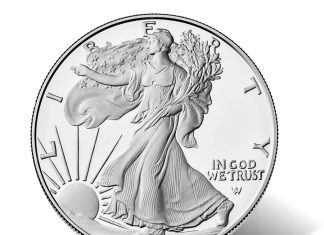A coin die is an extremely hardened, metal stamping tool that’s able to withstand the high pressures that are needed to strike coin planchets. At a die’s peak is the  reverse or negative image of the coin.
reverse or negative image of the coin.
For a mental image, think of a coin die as a shaped cookie cutter and the cookie dough as the coin planchet. Press them together and, bingo… you’re ready to cook!
Of course no cooking happens in the minting process. Instead, a mint’s coin press takes both the attached front and back dies, waits for a coin planchet to cycle through, and then, faster than the mind can comprehend, strikes and pounds the planchet multiple times under enormous pressure. The end result is the formation of the final coin.
What are coin dies worth?
Today’s coin dies are able to stamp tens of thousands of coins before being replaced. To prevent counterfeiting, used up coin dies are destroyed or defaced. It’s not uncommon to find these retired coin dies sold as a kind of novelty coin item. At the U.S. Mint, for example, you can purchase a coin and die set for under $40.
Retired coin dies can be an interesting desk item or conversation piece for sure. But they’re not on the minds of most daily coin collectors. Out of curiosity I purchased one some years back. Yet, I can’t say I know where it is… I do know where all my coins are though!






[…] the early history of coinage, dies were created by hand, resulting in each being unique. As such, coins had subtle differences from […]
In my humble opinion, one can speak like that about a modern die, of a modern mint which changes its dies frequently, process which makes those dies relatively common (not to mention how they’re manufactured). But all changes when it comes to older dies, let’s say medieval (or ancient!), that always are exceptionally rare finds. One must also remember that a die can be unique, while the coins it struck can be in the hundreds, thousands or even more. The coins were obtained by thesimple mechanical process of stamping a metal flan using a pair of dies and a hammer.… Read more »
Why does my coin have a copy stamp on the back. Is it fake.
Comemrative keepsake. Coins that are reproduced must say Copy” somewhere on the coin.
Jaime, you are essentially correct. The “copy stamp” is a means to indicate that the a piece is a copy of an original coin. It likely has no real monetary value unless it happens to be composed of a sizable portion of silver, gold, or some other precious metal.
I am looking for a coin die. that can say happy birthday, merry christmas, or something else to that effect. Please let me know were one can be purchased.
Thanks, Mark
would this be considered DD or poor mans DD?
Hi iam new to coin collecting and love your articles. I recently got a few rolls of pennies from the local store and found this 1992 D penny, the coloring is silver/steel it weights 2.5 I cannot find any information on it can you help?